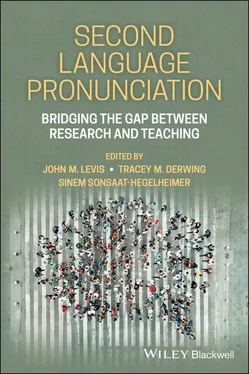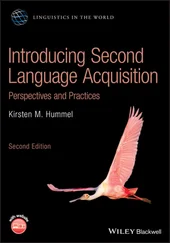46 Rojczyk, A. (2015). Using FL accent imitation in L1 in foreign- language speech research. In E. Waniek-Klimczak, & M. Pawlak (Eds.), Teaching and researching the pronunciation of English (pp. 223–233). Springer.
47 Saito, K., & Lyster, R. (2012). Effects of form‐focused instruction and corrective feedback on L2 pronunciation development of/ɹ/by Japanese learners of English. Language Learning, 62(2), 595–633. https://doi.org/10.1111/j.1467-9922.2011.00639.x
48 Sakai, M., & Moorman, C. (2018). Can perception training improve the production of second language phonemes? A meta-analytic review of 25 years of perception training research. Applied Psycholinguistics, 39(1), 187–224. https://doi.org/10.1017/S0142716417000418
49 Schmidt, R., & Frota, S. N. (1986). Developing basic conversational ability in a second language: A case study of an adult learner of Portuguese. In R. Day (Ed.), Talking to learn: Conversation in second language acquisition. Newbury House.
50 Scovel, T. (2000). A critical review of the critical period research. Annual Review of Applied Linguistics, 20, 213–223. https://doi.org/10.1017/S0267190500200135
51 Sheldon, A., & Strange, W. (1982). The acquisition of /r/ and /l/ by Japanese learners of English: Evidence that speech production can precede speech perception. Applied Psycholinguistics, 3(3), 243–261. https://doi.org/10.1017/S0142716400001417
52 Strange, W., & Shafer, V. L. (2008). Speech perception in second language learners: The re-education of selective perception. In J. G. Hansen Edwards & M. L. Zampini (Eds.), Phonology and second language acquisition (vol. 36, pp. 153–192). John Benjamins Publishing.
53 Thomson, R. I. (2007). Modeling L1/L2 interactions in the perception and production of English vowels by Mandarin L1 speakers: A training study. Unpublished Doctoral Dissertation, University of Alberta.
54 Thomson, R. I. (2011). Computer assisted pronunciation training: Targeting second language vowel perception improves pronunciation. CALICO Journal, 28(3), 744–765. https://www.jstor.org/stable/calicojournal.28.3.744
55 Thomson, R. I. (2012a). Improving L2 listeners’ perception of English vowels: a computer-mediated approach. Language Learning, 62(4), 1231–1258. https://doi.org/10.1111/j.1467-9922.2012.00724.x
56 Thomson, R. I. (2012b). English Accent Coach: Not quite a fairy godmother for pronunciation instruction, but a step in the right direction. CONTACT, 38(1), 18–24. http://contact.teslontario.org/wp-content/uploads/2016/04/ContactSpring2012.pdf
57 Thomson, R. I. (2016). Does training to perceive L2 English vowels in one phonetic context transfer to other phonetic contexts? Canadian Acoustics, 44 (3), 198–199. Proceedings of the annual conference of the Canadian Acoustics Association.
58 Thomson, R. I. (2018a). High Variability [Pronunciation] Training (HVPT): A proven technique about which every language teacher and learner ought to know. Journal of Second Language Pronunciation, 4(2), 207–230. https://doi.org/10.1075/jslp.17038.tho
59 Thomson, R. I. (2018b). English Accent Coach [Computer program]. Version 2.3. www.englishaccentcoach.com
60 Thomson, R. I. (2022). The relationship between L2 speech perception and production. In T. M. Derwing, M. J. Munro, & R. I. Thomson (Eds.), The Routledge handbook of second language acquisition and speaking. Routledge.
61 Thomson, R. I., & Derwing, T. M. (2015). The effectiveness of L2 pronunciation instruction: A narrative review. Applied Linguistics, 36 (3), 326–344. https://doi.org/10.1093/applin/amu076
62 Thomson, R. I., & Derwing, T. M. (2016). Is phonemic training using nonsense or real words more effective? In J. Levis, H. Le, I. Lucic, E. Simpson, & S. Vo (Eds.). Proceedings of the 7th Pronunciation in Second Language Learning and Teaching Conference, ISSN 2380-9566, Dallas, TX, October 2015 (pp. 88–97). Iowa State University.
63 Trofimovich, P., Lightbown, P. M., Halter, R. H., & Song, H. (2009). Comprehension-based practice: The development of L2 pronunciation in a listening and reading program. Studies in Second Language Acquisition, 31(4), 609–639. https://doi.org/10.1017/S0272263109990040
64 Wang, X., & Munro, M. J. (2004). Computer-based training for learning English vowel contrasts. System, 32(4), 539–552. https://doi.org/10.1016/j.system.2004.09.011
65 Werker, J. F. (2018). Perceptual beginnings to language acquisition. Applied Psycholinguistics, 39(4), 703–728. https://doi.org/10.1017/S0142716418000152
66 Werker, J. F., & Curtin, S. (2005). PRIMIR: A developmental framework of infant speech processing. Language Learning and Development, 1(2), 197–234.
67 Winitz, H., Gillespie, B., & Starcev, J. (1995). The development of English speech patterns of a 7-year-old Polish-speaking child. Journal of Psycholinguistic Research, 24(2), 117–143.
68 Zhao, T. C., & Kuhl, P. K. (2018). Linguistic effect on speech perception observed at the brainstem. Proceedings of the National Academy of Sciences, 115(35), 8716–8721.
Конец ознакомительного фрагмента.
Текст предоставлен ООО «ЛитРес».
Прочитайте эту книгу целиком, купив полную легальную версию на ЛитРес.
Безопасно оплатить книгу можно банковской картой Visa, MasterCard, Maestro, со счета мобильного телефона, с платежного терминала, в салоне МТС или Связной, через PayPal, WebMoney, Яндекс.Деньги, QIWI Кошелек, бонусными картами или другим удобным Вам способом.












